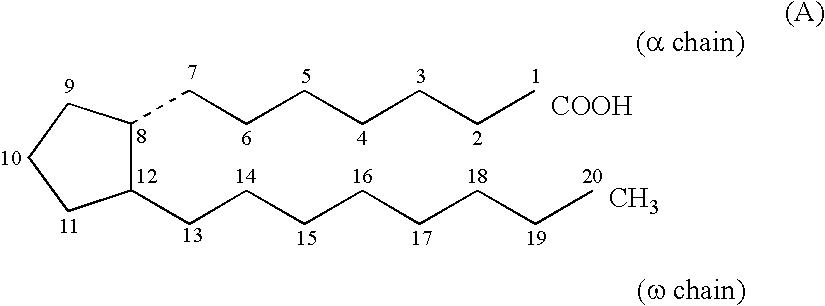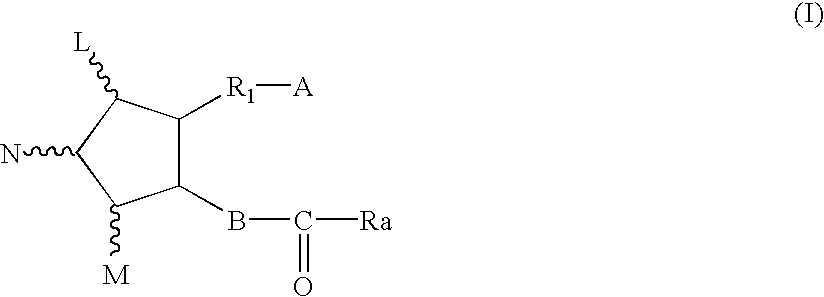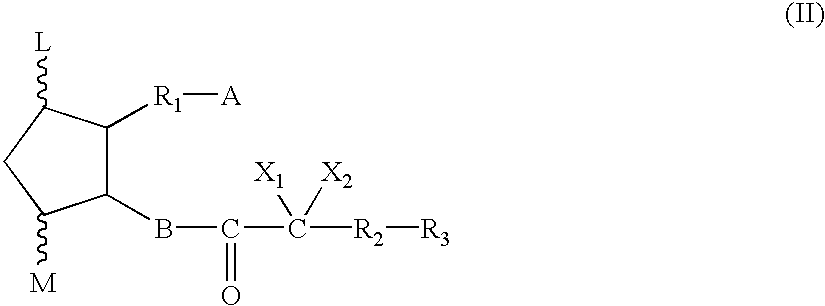Method for treating drug-induced constipation
a drug-induced constipation and 15-ketoprostaglandin technology, applied in the field of 15-ketoprostaglandin compound for treating drug-induced constipation, can solve the problems of inconvenient administration of morphine, inconvenient treatment, and inability to eat properly, and achieve strong antagonistic
- Summary
- Abstract
- Description
- Claims
- Application Information
AI Technical Summary
Benefits of technology
Problems solved by technology
Method used
Image
Examples
example 1
Antagonism to Morphine-Induced Constipation
[0131]Male ICR mice were fasted overnight in wire-bottomed cages to prevent coprophagia, and 15 mice were used for each group. Morphine hydrochloride (Takeda Chemical Industries, Ltd., Osaka Japan) was injected intraperitoneally to animals at 5 mg / kg. Immediately after the morphine-injection, 0.1 mL graphite marker (2:1 mixture of Pilot INK-30-B and 10% tragacanth mucilage) and 5 mL / Kg vehicle (physiological saline containing 0.01% polysorbate 80 and 0.5% ethanol) or 1, 10, or 100 μg / kg test substance (13,14-dihydro-15-keto-16,16-difluoro-PGE1) in 5 mL / Kg of the vehicle were administered orally. A normal control group received graphite marker and vehicle orally in the above volumes without the morphine-injection. One hundred and fifty minutes after the administration of graphite marker, animals were sacrificed by cervical dislocation, and examined the caecum for the presence of graphite marker. It was judged as a positive response when grap...
example 3
Effect on Analgesic Action
[0147]Male ICR mice were fasted overnight in wire-bottomed cages to prevent coprophagia. The tail of the animal was pinched with clamp forceps, and the response time from the tail-pinch to fierce striking, biting or crying was measured. 18 mice whose response time of 2 second or shorter were used as test animals. Morphine hydrochloride (Takeda Chemical Industries, Ltd., Osaka, Japan) was injected intraperitoneally to the animals at 5 mg / kg. Immediately after the morphine-injection, vehicle (physiological saline containing 0.01% polysorbate 80 and 0.5% ethanol) or 1, 10, or 100 μg / kg test substance (13,14-dihydro-15-keto-16,16-difluoro-PGE1) dissolved in the vehicle was administered orally in an administration volume of 5 mL / kg. The animals of normal control group received vehicle orally in the above volume without morphine-injection.
[0148]The response time of each animal following tail-pinch was measured 30, 60, 90, 120 and 150 minutes after the administrat...
example 4
Antagonism to Imipramine (A Tricyclic Antidepressant)-Induced Constipation
[0156]Male ICR mice were fasted overnight in wire-bottomed cages to prevent coprophagia, and 10 mice were used for each group. Imipramine hydrochloride (Wako Pure Chemical Industries, Ltd., Osaka, Japan) at 60 mg / kg was injected intraperitoneally to the animals. Immediately after the imipramine-injection, 0.1 mL of carbon marker (10% carbon powder suspension in 5% gum Arabic) and vehicle (physiological saline solution containing 0.01% polysorbate 80 and 0.5% ethanol) or test substance (13,14-dihydro-15-keto-16,16-difluoro-PGE1) in an administration volume of 5 mL / kg were orally administered. A normal control group received carbon marker and vehicle in the above volume orally without the imipramine-injection. One hundred and fifty minutes after the administration of carbon marker, animals were sacrificed by cervical dislocation, and examined the caecum for the presence of carbon marker. It was judged as a posit...
PUM
| Property | Measurement | Unit |
|---|---|---|
| response time | aaaaa | aaaaa |
| response time | aaaaa | aaaaa |
| response time | aaaaa | aaaaa |
Abstract
Description
Claims
Application Information
 Login to View More
Login to View More - R&D
- Intellectual Property
- Life Sciences
- Materials
- Tech Scout
- Unparalleled Data Quality
- Higher Quality Content
- 60% Fewer Hallucinations
Browse by: Latest US Patents, China's latest patents, Technical Efficacy Thesaurus, Application Domain, Technology Topic, Popular Technical Reports.
© 2025 PatSnap. All rights reserved.Legal|Privacy policy|Modern Slavery Act Transparency Statement|Sitemap|About US| Contact US: help@patsnap.com



